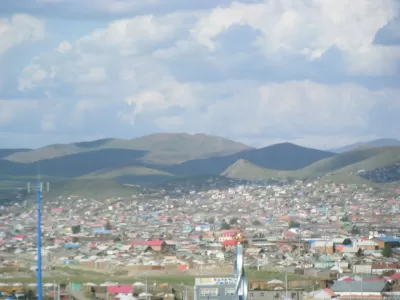Confronting a problem that affects roughly 75 percent of the world's population, a new system will give every place on Earth an address based on three words.

A new addressing system from a British company may have finally found a solution to a problem that affects close to 4 billion people around the world—the lack of a locatable home address. In many parts of the world, including developing nations like Mongolia, streets are often unnamed. Joon Ian Wong of Quartz reports that the start-up What3Words has taken on this problem by assigning a three word address that corresponds to a nine-square-meter location on the globe.
In What3Words’ system, the idea is that a series of words is easier to remember than the strings of number that make up GPS coordinates. Each unique phrase corresponds to a specific 9-square-meter spot on the map.
For example, the White House, at 1600 Pennsylvania Avenue, becomes sulk.held.raves; the Tokyo Tower is located at fans.helpless.collects; and the Stade de France is at reporter.smoked.received.
Wong reports that the What3Words system is being rolled out in the Mongolian capital of Ulaanbaatar, where many of the city's streets have no name. Previously, residents were required to travel to a designated mail stop or mailed items had to include detailed delivery instructions in order to get to the right location. The Mongolian postal system will convert the three words, using software licensed from What3Words, into GPS coordinates that will take deliveries to a small, specific location. Wong notes that the What3Words system is already being used by the United Nations, courier companies and others.
FULL STORY: Mongolia is changing all its addresses to three-word phrases

Study: Maui’s Plan to Convert Vacation Rentals to Long-Term Housing Could Cause Nearly $1 Billion Economic Loss
The plan would reduce visitor accommodation by 25,% resulting in 1,900 jobs lost.

North Texas Transit Leaders Tout Benefits of TOD for Growing Region
At a summit focused on transit-oriented development, policymakers discussed how North Texas’ expanded light rail system can serve as a tool for economic growth.

Using Old Oil and Gas Wells for Green Energy Storage
Penn State researchers have found that repurposing abandoned oil and gas wells for geothermal-assisted compressed-air energy storage can boost efficiency, reduce environmental risks, and support clean energy and job transitions.

Santa Barbara Could Build Housing on County Land
County supervisors moved forward a proposal to build workforce housing on two county-owned parcels.

San Mateo Formally Opposes Freeway Project
The city council will send a letter to Caltrans urging the agency to reconsider a plan to expand the 101 through the city of San Mateo.

A Bronx Community Fights to Have its Voice Heard
After organizing and giving input for decades, the community around the Kingsbridge Armory might actually see it redeveloped — and they want to continue to have a say in how it goes.
Urban Design for Planners 1: Software Tools
This six-course series explores essential urban design concepts using open source software and equips planners with the tools they need to participate fully in the urban design process.
Planning for Universal Design
Learn the tools for implementing Universal Design in planning regulations.
Ascent Environmental
Borough of Carlisle
Institute for Housing and Urban Development Studies (IHS)
City of Grandview
Harvard GSD Executive Education
Toledo-Lucas County Plan Commissions
Salt Lake City
NYU Wagner Graduate School of Public Service


























